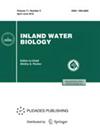严重受压冷却水库中浮游生物群的变化
IF 0.7
4区 生物学
Q4 MARINE & FRESHWATER BIOLOGY
引用次数: 0
摘要
摘要介绍了对哈拉诺尔斯卡亚国家地区发电站(SDPP)(外贝加尔地区)冷却水库的长期研究结果。确定了由技术和生物因素影响决定的浮游植物和浮游动物的发展阶段。显示了浮游生物群落对热负荷变化的反应。藻类密集生长和无脊椎动物大量繁殖的时期与水生生物的数量和生物量显著下降的时期交替出现,这表明正在形成的冷却池塘技术生态系统处于不稳定状态。本文章由计算机程序翻译,如有差异,请以英文原文为准。

Transformation of Planktonic Assemblages in a Severely Stressed Cooling Reservoir
Abstract
The results of long-term studies in the cooling reservoir of the Kharanorskaya State District Power Plant (SDPP) (Trans-Baikal Area) are presented, conventionally divided into four periods depending on the increase in its capacity. The stages of phyto- and zooplankton development determined by the influence of technogenic and biotic factors are determined. The response of plankton communities to changes in heat load is shown. Periods of intensive vegetation of algae and mass development of invertebrates alternate with a significant decline in the abundance and biomass of hydrobionts, which indicates an unstable state of the forming cooling pond technoecosystem.
求助全文
通过发布文献求助,成功后即可免费获取论文全文。
去求助
来源期刊

Inland Water Biology
生物-海洋与淡水生物学
CiteScore
1.30
自引率
55.60%
发文量
87
审稿时长
6-12 weeks
期刊介绍:
Inland Water Biology publishes thematic reviews and original papers devoted to flora and fauna in waterbodies, biodiversity of hydrobionts, biology, morphology, systematics, ecology, ethology, ecological physiology and biochemistry of aquatic organisms, patterns of biological cycle, structure and functioning of aquatic ecosystems, anthropogenic and uncontrolled natural impacts on aquatic organisms and ecosystems, invasion of nonindigenous species into ecosystems and their ecology, methods of hydrobiological and ichthyological studies.
 求助内容:
求助内容: 应助结果提醒方式:
应助结果提醒方式:


